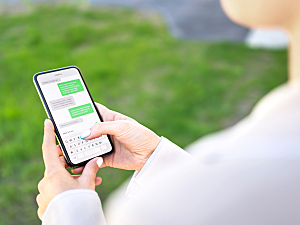As soon as a woman is diagnosed with gestational diabetes mellitus (GDM), she must quickly start intensive self-monitoring of blood glucose (SMBG), typically four times daily. Poor adherence is common and increases the risk of preeclampsia and other poor pregnancy outcomes.
Brigham and Women’s Hospital team has developed an automated two-way text messaging program designed to encourage SMBG in women with GDM. Rachel A. Blair, MD, an endocrinologist in the Division of Endocrinology, Diabetes and Hypertension, Marie E. McDonnell, MD, director of the Diabetes Management Program in the Division, Ellen W. Seely, MD, director of clinical research in the Division, and colleagues report promising results from a usability and acceptability study in JMIR Human Factors.
About the Program
The program, called Text 4 Success, was developed with the participation of 10 patients. The program uses an SMS texting platform that sends reminders to check blood glucose, messages giving positive feedback on the values, educational messages, and motivational messages. An algorithm selects the feedback to be given.
Out-of-range glucose values automatically prompt patients to contact their clinical team. Patients are informed that their clinicians will not monitor the messages in real-time.
All information on the texting platform is written at an eighth-grade reading level or below and is available in English or Spanish.
Study Methods
The usability study included 10 adult women with GDM, average age of 37, who were ≤36 weeks of gestation at enrollment. All had completed a college degree, and two had completed a graduate degree. Three were nulliparous, and three had GDM during a prior pregnancy. At enrollment, all participants were already self-monitoring their blood glucose with a glucometer or, in one case, a continuous glucose monitor.
Women received text messages for two weeks. Afterward, they rated components of the program on a Likert scale from 1 to 5 and participated in semistructured interviews to provide feedback. They received a parking voucher for completing the study.
Usability
Details of the user experience were:
- No one unsubscribed from the text messages during the study period
- Collectively, the participants responded to 380 of the 560 messages received (68%)
- All participants stated they would recommend the program to other women with GDM; one mentioned it would be more helpful for women not checking their glucose frequently
- Four participants wanted to use the program for two weeks, one wanted to use it for one to two months, four wanted to use it for their entire pregnancy, and one wanted the flexibility to decide
- Eight women thought the number of text messages was just right; the other two thought there were too many
A table in the article summarizes user feedback on individual components of the program. The authors also give a synopsis of the comments received during the interviews.
Adherence
During the week before study enrollment, the participants checked a median of 93% of recommended fingerstick blood glucose levels. During the study, that figure was 97%, not a significant improvement.
The study was not powered to detect a difference in adherence, but the findings suggest the program would be best suited to patients with lower baseline adherence to SMBG.
Next Steps
Participants’ suggestions for improving the program included having more customizability and functionality, such as more flexibility about mealtimes and the ability to aggregate blood glucose values into a chart or graph. These ideas will be incorporated into the next iteration. Eventually, a randomized controlled trial may be conducted to assess how the program affects adherence to SMBG.
